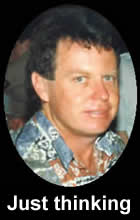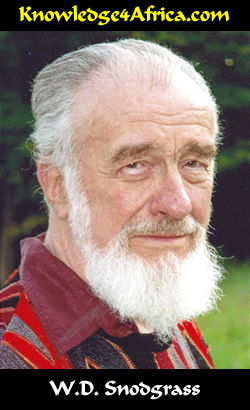|
READ THIS
The poet is rummaging through old documents when he comes across a picture of his wife, but at a time
when they were still dating. He is initially shocked upon seeing it but then it brings back a sense of
nostalgia because it was this picture which had helped him through the fearful war years.
He is also reminded of the dreadful days of their marriage, when affection disappeared and their
relationship ended in divorce. Nevertheless, he keeps the picture and knows that one day he will look at
it again.
 A NOTE ON THE POET
A NOTE ON THE POET
William De Witt Snodgrass was born in January 1926 in Beaver Falls, Pennsylvania. He graduated from
the local high school in 1943 and thereupon attended Geneva College until 1944 when he was drafted into
the United States navy for the remainder of World War II.
After he had been demobilized from the navy in 1946, he moved to the University of Iowa where he
enrolled in the Iowa Writers' Workshop, intending initially to become a playwright but eventually joining
the poetry workshop. He received a B.A. in 1949, Masters in 1951, and a Masters degree in Fine Arts in
1953.
The poet had a distinguished academic career, teaching at Cornell University, Rochester, Wayne State,
Syracuse, Old Dominion and, finally, the University of Delaware. He retired from teaching in 1994 and
thereupon devoted himself to his writing.
Although he disliked the title, Snodgrass became known as the father of "the confessional school of
poetry", a school that rose to prominence in America during the 1960s and of which Robert Lowell and
Sylvia Plath were adherents.
He was known to his friends as "Dee" but only published using his initials. He was married no less
than four times.
The poet won several awards in poetry, including the prestigious Pulitzer Prize for Poetry in 1960.
He died of lung cancer in 2009 at his home in Madison County, New York, at the age of 83. He was
survived by Kathleen Snodgrass, his fourth wife who was herself a recognised writer.
Have you looked at the questions
in the right column?
|
TEST YOURSELF!
Read the left column and then answer
the following questions:
"Sorting out letters and piles of my old
Canceled checks, old clippings, and yellow note cards
That meant something once, I happened to find
Your picture. That picture. I stopped there cold,
Like a man raking piles of dead leaves in his yard
Who has turned up a severed hand."
- What two words in this stanza tell us that the poet is an American. How would we write these
words? (2)

[Need help?]
canceled = cancelled; check = cheque.
|
- What is a "check"? What is a "canceled check"? Why does the poet still keep the
"canceled checks"? (6)

[Need help?]
In the old days before credit and debit cards came to rule, cheques were a common means of financial
transactions. One wrote out a cheque and this was duly forwarded to the bank for the transfer of funds.
Once the funds had been paid out, the cheque was cancelled and then returned to the drawee or person
who issued it. This was thereupon kept as proof of payment. The diligent person would then file the
cheques and keep them lest there was a query even many years later.
|
- What would "old clippings" refer to? (2)

[Need help?]
"Old clippings" would be the articles of interest from newspapers or magazines which the poet had
cut out and kept.
|
- Why would the "note cards" be yellow? (2)

[Need help?]
The note cards were so old that they had become yellow with age.
|
- What is the significance for the poem as a whole of the words "That meant something
once"? (2)

[Need help?]
The whole poem is about mementos which had once had had meaning to the poet. Of course, the biggest
of these mementos was a picture of his ex-wife, but at a time when she was still young and they were still
dating. Like the other mementos, this picture had also once meant something to him.
|
- Why does the poet put the words "that" in italics in the expression "That
picture"? (2)

[Need help?]
It's an exclamation. Finding the picture is a shock to the poet because he had not seen it for a long time.
Indeed, it's a picture of a woman whom he has now come to dislike.
|
- How do you know that finding the picture gives the poet quite a shock? (4)

[Need help?]
The poet says that he stopped there "cold". It was like finding a "severed hand" in a pile of
leaves that he was raking.
|
"Still, that first second, I was glad: you stand
Just as you stood -- shy, delicate, slender,
In that long gown of green lace netting and daisies
That you wore to our first dance. The sight of you stunned
Us all."
- Was the poet immediately pleased he had found the photograph? How do you
know? (4)

[Need help?]
No, the poet was NOT immediately pleased. He says the picture stopped him "cold" as if he had
seen a "severed hand" in a pile of leaves.
Nevertheless, almost immediately after that, he was indeed glad. He says, "Still, that first second,
[later] I was glad."
|
- How long had the poet known the woman at the time that the picture had been taken? How do you
know? (4)

[Need help?]
The poet had probably not known her long at all. The picture had been taken at their first dance. In those
days, dancing was considered an innocent way in which couples could get to know each other and so they
tended to dance often. Indeed, a man would soon have invited a woman to a dance if he had liked her.
|
- What was it that the poet found so attractive in her as opposed to their later married
life? (4)

[Need help?]
In the days when they had just started dating, she was very young and still shy. She would have been
hesitant to express her mind. She was also "delicate, slender" -- in other words, young, slim, good
looking and saying little that would offend.
|
|



